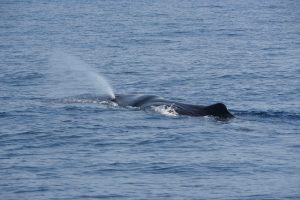We wrapped up our early summer field season this week with three excellent days off Cape Hatteras. Overall, we deployed 15 satellite-linked transmitters: 10 on short-finned pilot whales, 3 on Cuvier’s beaked whales and one each on a pelagic bottlenose dolphin and a sperm whale (our first tag deployment on the latter). In addition, we deployed two Digital Acoustic Tags on pilot whales.

Sunday was a particularly good day – with three tags out on Ziphius and another on a sperm whale. We enjoyed gorgeous conditions that allowed us to relocate these deep-diving whales after their long submergences. The good conditions allowed us to work about 40 nautical miles from shore, well outside the shelf break in the deep waters that these species prefer. We also recorded our first sighting of a pygmy or dwarf sperm whale (Genus Kogia) – these cryptic animals strand frequently in the southeastern U.S. but are almost never observed at sea.

One of the adult male beaked whales we tagged was well known to us – we deployed a DTag on him last year. Two of the satellite transmitters on beaked whales and the sperm whale tag will send data on the diving behavior of these animals in addition to their locations. One of the beaked whales we tagged last year made a dive of 2,800 m. Pretty impressive on a single breath.

We’ll continue to follow the movements and behavior of these animals from our computers over the summer and we’ll be back again in the fall with Daniel Webster from Cascadia to deploy another round of tags. You can follow the adventures of these whales on Movebank.




